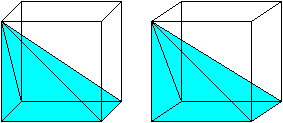Why is the volume of a cone one third of the volume of a cylinder?
The volume of a cone with height $h$ and radius $r$ is $\frac{1}{3} \pi r^2 h$, which is exactly one third the volume of the smallest cylinder that it fits inside.
This can be proved easily by considering a cone as a solid of revolution, but I would like to know if it can be proved or at least visual demonstrated without using calculus.

A visual demonstration for the case of a pyramid with a square base. As Grigory states, Cavalieri's principle can be used to get the formula for the volume of a cone. We just need the base of the square pyramid to have side length $ r\sqrt\pi$. Such a pyramid has volume $\frac13 \cdot h \cdot \pi \cdot r^2. $
Then the area of the base is clearly the same. The cross-sectional area at distance a from the peak is a simple matter of similar triangles: The radius of the cone's cross section will be $a/h \times r$. The side length of the square pyramid's cross section will be $\frac ah \cdot r\sqrt\pi.$
Once again, we see that the areas must be equal. So by Cavalieri's principle, the cone and square pyramid must have the same volume:$ \frac13\cdot h \cdot \pi \cdot r^2$
One can cut a cube into 3 pyramids with square bases -- so for such pyramids the volume is indeed 1/3 hS. And then one uses Cavalieri's principle to prove that the volume of any cone is 1/3 hS.